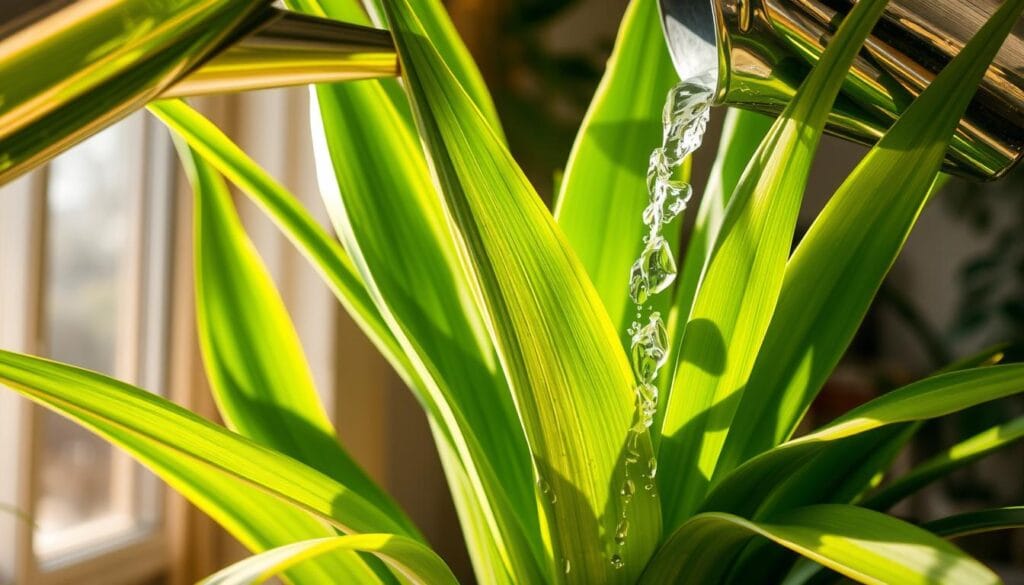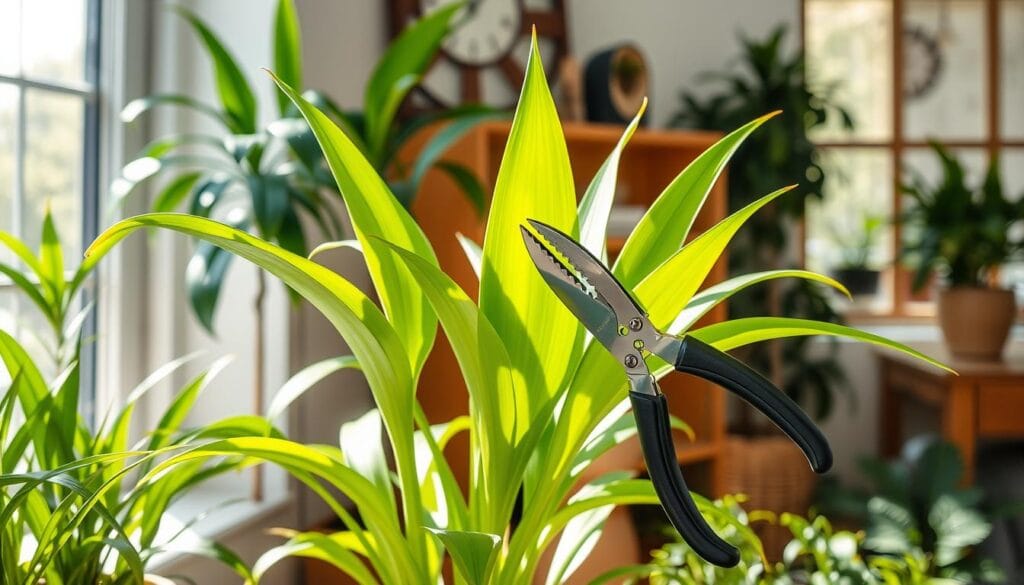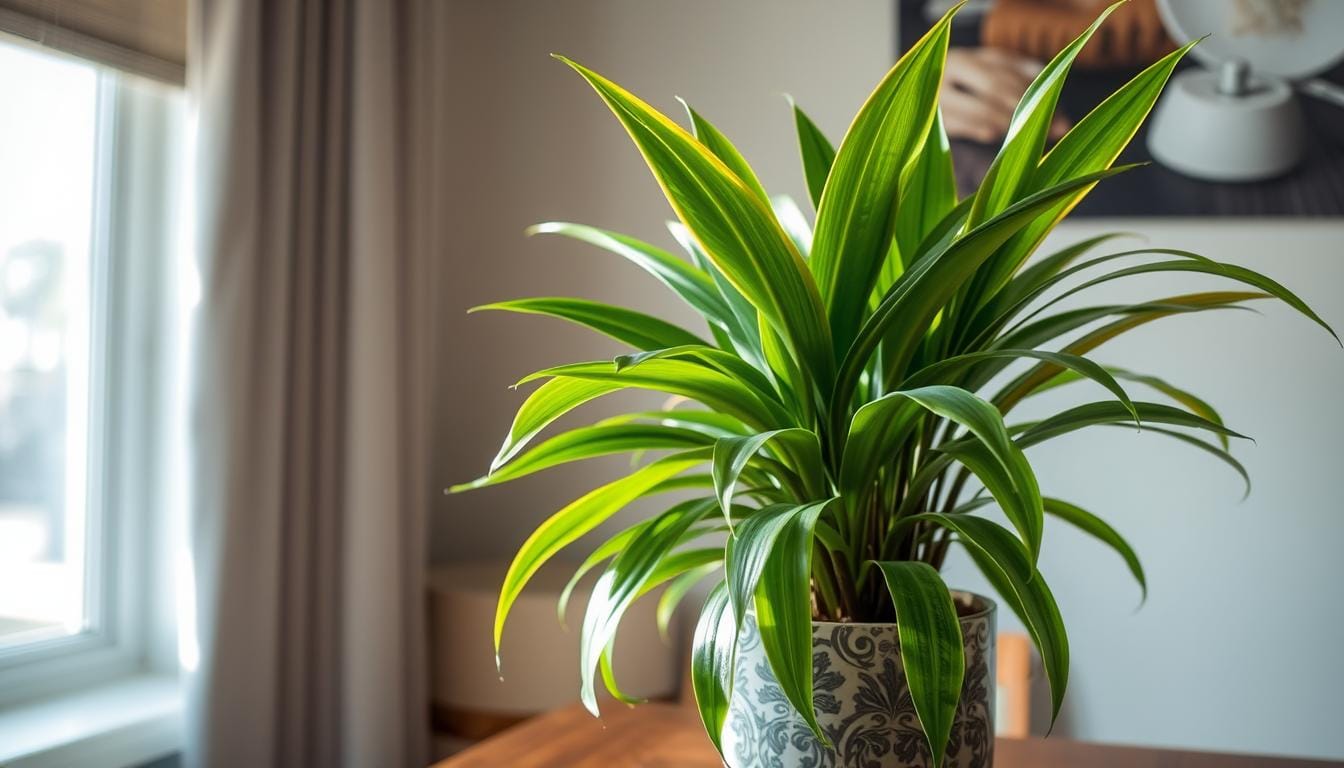Dracaena plants, also known as “dragon trees,” are a favorite for indoor gardens. They are known for their beautiful leaves and ability to thrive indoors. This guide will help you grow healthy dracaena plants at home, whether you’re new to plants or have lots of experience.
Key Takeaways
- Dracaena plants are versatile and low-maintenance indoor houseplants
- They thrive in a variety of light conditions and tolerate a range of temperatures
- Proper watering and soil requirements are crucial for healthy dracaena growth
- Regular pruning and maintenance can help maintain the plant’s shape and appearance
- Dracaena plants can be easily propagated through stem cuttings or air layering
Introduction to Dracaena Plant: Nature’s Indoor Beauty
Dracaena plants are a stunning addition to any home. They not only make your space look better but also have many benefits. With so many dracaena varieties to pick from, you can find the perfect one for you.
Popular Dracaena Species for Home Growing
The Dracaena marginata, Dracaena fragrans, and Dracaena deremensis are favorites for indoor growing. These tropical plants have beautiful leaves in various colors. They can add a pop of color to any room.
Benefits of Growing Dracaena Indoors
- Exceptional air purifying abilities, removing harmful toxins
- Low-maintenance and easy to care for, perfect for busy people
- Improve the look and feel of your home
- Help improve mental health and focus
Adding dracaena plants to your home is a great way to bring nature inside. They are perfect for both experienced and new plant lovers. These tropical plants are sure to impress and bring joy.
“Dracaena plants are the unsung heroes of the indoor plant world, offering a stunning visual appeal while also purifying the air and boosting our mental well-being.”
Essential Growing Requirements for Your Dracaena
If you’re looking for a low-maintenance plant that does well in dim light, the dracaena is perfect. These plants are known for their vibrant leaves and air-purifying abilities. To keep your dracaena happy, knowing its basic needs is key.
Dracaenas can handle different environments but love bright, indirect light. Position your plant where it gets plenty of low light but avoid direct sun to prevent leaf burn.

Temperature and humidity are also important for dracaena care. They do best in temperatures between 65°F and 75°F. They also like a humid environment. To keep humidity up, use a pebble tray or mist the leaves often.
Dracaenas need well-draining, slightly acidic soil. Stay away from dense, wet soil to prevent root rot. Fertilizing with a balanced, diluted formula helps them grow strong.
By meeting your dracaena’s basic needs, you’ll enjoy its many benefits. This adaptable plant is a great addition to any home.
Light and Temperature Requirements
Dracaena plants are known for growing well in low light. But, knowing the best light and temperature is key to their health.
Optimal Light Conditions
Dracaena plants love bright, indirect sunlight. They can handle different light levels but avoid direct sun to prevent leaf burn. Place them near a north- or east-facing window for the best light.
Temperature and Humidity Needs
Dracaena plants do well in temperatures between 65°F to 75°F (18°C to 24°C). They don’t like extreme temperatures. Keep the temperature steady and the humidity moderate to high.
Seasonal Light Adjustments
Dracaena plants need light adjustments with the seasons. In winter, use grow lights or brighter spots to make up for less daylight. In summer, provide shade to avoid leaf burn.
| Light Requirement | Temperature Range | Humidity Level |
|---|---|---|
| Bright, indirect sunlight | 65°F to 75°F (18°C to 24°C) | Moderate to high |

“Dracaena plants are the perfect choice for those seeking low-maintenance, indoor-friendly foliage that can adapt to a variety of lighting conditions.”
Soil and Potting Guidelines
To grow thriving dracaena plants, the right soil and potting practices are key. These houseplants and ornamental plants need a mix that drains well and is rich in nutrients. This mix helps them grow strong and healthy.
The best soil for dracaena plants is a mix of well-draining potting soil, perlite, and organic matter. This mix keeps the soil moist but not too wet. It also ensures good air circulation and nutrient availability. Make sure the container has enough holes for water to drain.
| Soil Composition | Drainage Requirements | Repotting Frequency |
|---|---|---|
| 60% potting soil, 20% perlite, 20% compost or peat moss | Containers with ample drainage holes | Every 2-3 years or when the plant outgrows its current pot |
Repotting should happen every 2-3 years or when the plant needs a bigger home. Carefully remove the plant from its old pot. Loosen any tight roots. Then, put it in a new, slightly larger pot filled with the right soil mix. This gives your dracaena plant room to grow and expand its roots.
By following these guidelines, your dracaena plant will stay healthy and vibrant. It will reach its full potential as a beautiful indoor plant. With the right soil and container, your dracaena will become a lush, eye-catching addition to your home or office.
Watering and Moisture Management
Proper watering is key for your dracaena plants, whether indoors or outdoors. Knowing the signs of too much or too little water is important. Also, the quality of water matters a lot for your plants.
Signs of Over and Under Watering
Dracaena plants don’t like too much or too little water. Too much water can cause yellow leaves, wilting, and root rot. Too little water makes leaves dry and stunted growth. Watch your plant closely and adjust watering as needed.
Water Quality Requirements
The water you use for your dracaena is very important. Don’t use tap water because it has minerals and additives that can harm your plant. Use filtered, purified, or distilled water instead. This ensures your dracaena gets the right moisture to grow well.
| Watering Frequency | Soil Moisture | Plant Appearance |
|---|---|---|
| Overwatering | Consistently moist or saturated | Yellowing leaves, wilting, root rot |
| Underwatering | Dry, crumbly soil | Dry, crispy leaves, stunted growth |

“Proper watering is the foundation for a healthy, thriving dracaena plant. Striking the right balance is key to ensuring your indoor oasis remains lush and vibrant.”
Fertilizing Your Dracaena Plant
Proper fertilization is key for your dracaena plant to grow well and look great. These plants need a balanced diet of nutrients. You can give them this through careful fertilizing.
To fertilize your dracaena right, find a balanced, water-soluble fertilizer for houseplants. Use it at half the recommended strength. Do this every two to three months when it’s growing (spring and summer).
Dracaena plants don’t like too much fertilizer. Too much can hurt their growth, make leaves look bad, and damage roots. Always read the fertilizer instructions well. Don’t fertilize in winter when the plant doesn’t need as much.
Seasonal Fertilization Adjustments
Change how often you fertilize your dracaena with the seasons. In spring and summer, fertilize every four to six weeks. But in fall and winter, fertilize every three to four months, or maybe not at all.
| Season | Fertilization Frequency |
|---|---|
| Spring and Summer | Every 4-6 weeks |
| Fall and Winter | Every 3-4 months |
By following these tips, your dracaena will get the nutrients it needs. This will help it grow lush and stay healthy in your home.

“Proper fertilization is the key to a thriving, long-lived dracaena plant. Follow the guidelines, and you’ll be rewarded with a stunning, low-maintenance houseplant.”
Pruning and Maintenance Tips
Proper pruning and maintenance are key for your dracaena to stay healthy and vibrant. A few simple steps can help shape your dracaena, remove dead leaves, and promote bushy growth. This will make your plant look lush and attractive.
Proper Pruning Techniques
Pruning your dracaena is easy and should be done a few times a year. First, find any dead, damaged, or yellow leaves and carefully cut them off with clean scissors or pruning shears. Don’t cut into the main stem or trunk, as it can harm the plant.
To shape your dracaena, look for stems that are out of place. Trim them to the height or angle you prefer. Remember not to cut off more than one-third of the leaves at once, as it can stress the plant.
Maintaining Plant Shape
Regularly rotating your dracaena helps keep it balanced and promotes even growth. Just turn the pot a quarter-turn every few weeks. This ensures the dracaena gets light evenly, preventing it from leaning or becoming lopsided.
By following these easy care tips, your dracaena will thrive for years. With a bit of care, it will bring natural beauty to any room.

Common Pests and Diseases
Dracaena plants are tough, but they can still get sick. It’s important to spot and fix problems fast to keep your plant looking good.
Pests to Watch Out For
- Spider mites: These tiny arachnids can cause discoloration, webbing, and leaf drop on dracaenas.
- Mealybugs: Fluffy white insects that feed on the plant’s sap, leading to stunted growth and leaf drop.
- Scale insects: These small, hard-shelled pests attach themselves to the leaves and stems, sapping the plant’s nutrients.
- Thrips: Minute insects that can cause silvery, speckled damage to dracaena foliage.
Common Diseases and Ailments
- Root rot: Caused by overwatering and poor drainage, leading to yellowing, wilting, and eventual plant death.
- Leaf spot: Fungal infections that create unsightly brown or black spots on the leaves.
- Leaf scorch: Caused by excessive sun exposure, resulting in dried, crispy leaf edges.
- Bacterial blight: A bacterial infection that can cause leaf discoloration, wilting, and stem dieback.
| Pest/Disease | Symptoms | Treatment |
|---|---|---|
| Spider Mites | Discoloration, webbing, leaf drop | Insecticidal soap, neem oil, or predatory mites |
| Mealybugs | Stunted growth, leaf drop | Alcohol-based insecticides, manual removal |
| Root Rot | Yellowing, wilting, plant death | Improve drainage, reduce watering, repot in fresh soil |
| Leaf Scorch | Dried, crispy leaf edges | Provide shade, increase humidity |
Keep an eye on your dracaena and fix problems quickly. This way, your plant will stay healthy and beautiful in your home.
“A healthy dracaena is a joy to behold, adding a touch of tropical elegance to any indoor space.”
Propagation Methods and Tips
It’s easy to grow your dracaena collection or share these plants with friends. They have great propagation abilities. You can use stem cutting or air layering, each with its own benefits.
Stem Cutting Propagation
Stem cutting is simple. It lets you make new dracaena plants from healthy stems. Choose a stem, cut just below a leaf node, and plant it in good potting mix.
With the right care, like keeping it moist and sunny, your new plant will grow well.
Air Layering Technique
Air layering is for those who want to try something more. It involves making a small cut on a stem, then wrapping it in damp moss. Secure it with plastic.
As roots grow in the moss, you can pot the new plant. This way, you can grow more dracaena varieties, indoor plants, and easy care plants.





